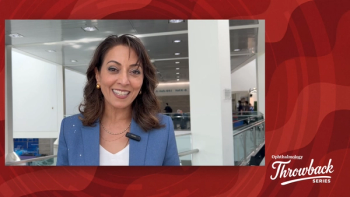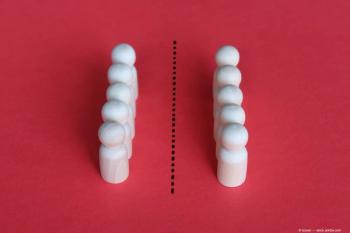
ARVO LIVE: Phase 3 OAKS and DERBY updates
Ophthalmology Times® talked with Allen Chiang, MD, about the assessment of geographic atrophy progression from the Phase 3 OAKS and DERBY trials at this year's ARVO meeting.
Ophthalmology Times® talked with Allen Chiang, MD, about the assessment of geographic atrophy progression from the Phase 3 OAKS and DERBY trials at this year's ARVO meeting.
Video transcript
Editor’s note: Transcript lightly edited for clarity.
Allen Chiang, MD:
Hi, this is Allen Chiang from Wills Eye Hospital Mid Atlantic Retina. I'm here at the 2023 ARVO conference, being able to present, very happy to present the assessment of geographic atrophy progression for the Phase 3 OAKS and DERBY trials.
I'll be presenting a review of the top-line data, which as most of you know, led to the recent FDA approval of pegcetacoplan for GA secondary to AMD. The combined data showed that at 24 months, there was a reduction of 20% for the monthly treated eyes, versus sham. And 17% for the every-other-month treatment eyes versus sham. But interestingly, if we look at the piecewise, slope, linear slope analysis, we find that in 6 month segments, that there's an increasing treatment effect over time. Indicating that staying on therapy is really important. In fact, in that last 6 months between month 18 and 24, we saw that the monthly treated eyes had a 30% reduction versus 24%, for the every-other-month treatment eyes, versus sham.
In addition to reviewing this and a quick overview of the AEs of interest at 24 months, I'll be presenting a lot of data regarding the 3 post-hoc analyses.
The first of which is a quartile analysis looking at the slow versus fast progressors. And what we found is that the distribution of treated eyes fell into the quartile one or slow progressors, to a much greater degree about 50 to 60%, compared to the quartile for or fast progressors, which tended to lean heavily towards the sham, eyes.
The second post-hoc analysis has to do with tissue preservation and the concept of, now that we have the ability to slow or reduce GA lesion growth, how does that translate into tissue preservation? When we look at the combined data, we found that, based on macular RPE density work done by Christine Curcio and others, we did a calculation directly from the pre-specified primary analysis. And we could find that we're saving many thousands, 5000 to 6000 cells, of RPE in the monthly treated eyes and just slightly less than the every other month treated eyes.
But then we look further into non-foveal lesions, we find that the tissue preservation is even greater up to 10,000 RPE cells for monthly the treated eyes. And so this lends or suggests that, in non-foveal eyes, especially tissue preservation, with treatment with pegcetacoplan can be quite significant. And remember that RPE cells support numerous photoreceptor cells.
And then finally, the last post-hoc analysis has to do with looking at visual function. And we looked at visual function as relating to foveal occupancy, which is a concept allowing us to adjust for that co-variant. [inaudible]. This is important because there was a lot of heterogeneity in the GA lesions that were involved in the initial Phase 3 trials.
And so by looking at the visual function in this way, we were able to find in a post-hoc analysis that in the in the lesions that were further away from foveal center by 250 microns, we're able to see a visual function benefit. They lost just over a line less at 24 months compared to sham. And the same goes for the quality of life measure as measured by the NEI-VFQ. There was a 4 point difference which is considered clinically meaningful based on some other wet AMD studies in the past.
Leaning towards the treated eyes, they had a 4 point over the sham. And so although this was not true for lesions, closer to the foveal center than 250 microns, this did seem to be the case for the ones further away. This suggests that earlier treatment can portend and may portend a visual function benefit.
So that's in summary, many parts to this talk. A lot of data to unpack as we all continue to digest what was just recently FDA approved, and what is ushering a new treatment era for AMD and geographic atrophy. Thanks
Newsletter
Don’t miss out—get Ophthalmology Times updates on the latest clinical advancements and expert interviews, straight to your inbox.


















































.png)


